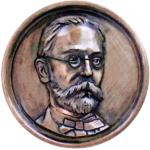Current issue
Online first
Special issues
Archive
About the Journal
Editorial Board
Editorial Council
Reviewers
Editorial guidelines
Publication ethics
Guidelines for reviewing
Remarks on “ghostwriting”
Copyrights and Open Access rule
GDPR Privacy Notice – for the authors of articles sent for publication in the "Komunikaty Mazursko-Warmińskie ("Masuro-Warmian Bulletin")
Contact
Price list
Epitaph of Johann Jungshulz in the church of St. Mary of the former Dominican monastery in Elbląg (Elbing)
Online publication date: 2019-07-20
Publication date: 2019-07-20
KMW 2019;304(2):347-378
KEYWORDS
TOPICS
ABSTRACT
The funeral epigraphic material of Elbląg and the surrounding area, relating to the period preceding the
XVIth century, remains, first of all thanks to the researches of Polish epigraphists, relatively more explored and
introduced into the scientific circulation array. At the same time the Renaissance-Baroque gravestone monument
of the XVIth–XVIIth centuries, which is extremely important for the comprehensive study of the reformed Circum-Baltic, often continues to need a detailed research commentary. To the epitaph of the burgomaster of Elbing
(Elbląg) Johann Jungschultz (1583–1630), as well as to the Latin text of the funeral Eulogy, associated with this epitaph, composed by the Bohemian humanist Venceslav Klemens, is expected to address in this article. The epitaph
of Johann Jungschultz was established in 1630–1640. From the compositional point of view closest to the epitaph
of Johann Jungschultz, and almost prototypical for it, is the epitaph of Edward Blemke (1591), in the St. Mary’s
church of Gdansk. It allows to speak about the author of the epitaph of Johann Jungschultz as oriented to samples
of the Dutch monumental tombstones of the end of the XVIth century, or even as belonging to the circle of Willem van den Blocke (circa 1550–1628), which was the principal mediator of the influence of the Dutch art in the
South-Eastern Baltic in the end of XVIth – the first quarter of the XVIIth century. The compositional and decorative
solution of the epitaph also has close matches in the works of Johann Pfister (1573 – circa 1642/1645 or 1648).
Share
RELATED ARTICLE
We process personal data collected when visiting the website. The function of obtaining information about users and their behavior is carried out by voluntarily entered information in forms and saving cookies in end devices. Data, including cookies, are used to provide services, improve the user experience and to analyze the traffic in accordance with the Privacy policy. Data are also collected and processed by Google Analytics tool (more).
You can change cookies settings in your browser. Restricted use of cookies in the browser configuration may affect some functionalities of the website.
You can change cookies settings in your browser. Restricted use of cookies in the browser configuration may affect some functionalities of the website.




